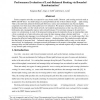Free Online Productivity Tools
i2Speak
i2Symbol
i2OCR
iTex2Img
iWeb2Print
iWeb2Shot
i2Type
iPdf2Split
iPdf2Merge
i2Bopomofo
i2Arabic
i2Style
i2Image
i2PDF
iLatex2Rtf
Sci2ools
ICNP
1997
IEEE
1997
IEEE
Balanced Routing
Future computer networks are expected to carry bursty traffic. Shortest -path routing protocols such as OSPF and RIP have t he disadvantage of causing bottlenecks due to their inherent single -path routing. That is, the uniformly selected shortest path between a source and a destination may become highly congested even when many other paths have low utilization. We propose a family of routing schemes that distribute data traffic over the whole network via bounded randomization; in this way, they remove bottlenecks and consequently improve network performance. For each data message to be sent from a source s to a destination d, each of the proposed routing protocols randomly choose an intermediate node e from a selected set of network nodes, and routes the data message along a shortest path from s to e. Then, it routes the data message via a shortest path from e to d. Intuitively, we would expect that this increase the effective bandwidth between each source -destination pair. Our simu...
Related Content
| Added | 06 Aug 2010 |
| Updated | 06 Aug 2010 |
| Type | Conference |
| Year | 1997 |
| Where | ICNP |
| Authors | Jorge Arturo Cobb, Mohamed G. Gouda |
Comments (0)

